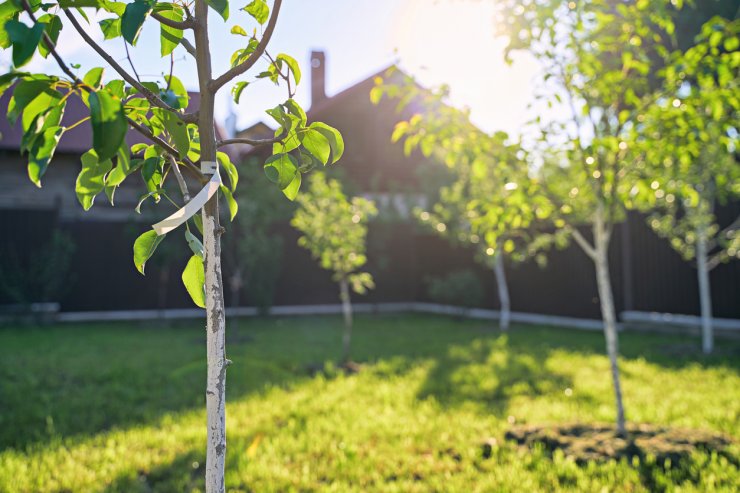
Pear trees freshly planted in open land.
If you treat them right, pear trees will generously supply you with delicious fruit for years to come. But like all plants, they need optimal conditions in order to flourish.
Pear trees need more consistently warm conditions than apples in order to provide a reliable crop. A quick check with your local garden shop or extension center will let you know if you’re in the right spot to plant pear trees.
Pears need fertile, well-drained soil, in an area that can protect them from frost. One of the hazards of raising pear trees is that a cold snap in the spring after the tree has flowered can affect your tree’s chances at getting pollinated. This is where you want to understand your microclimate—the finer points of hot/cold, wet/dry spots in your garden. Finding a frost-free sheltered spot for your pear trees will save you a lot of headaches when frost hits.
So, pears need warm conditions, protection from frost, and they’re totally trainable. That means… you can plant them in the ground, in raised beds, or in containers. As long as you have room for the trees to branch out, you’re not really limited in where you grow them. Just remember that you’re going to need at least two (and, in some cases, three) trees for cross-pollination, and you’re going to need to spread them out anywhere from 5 to 20 feet.
If you have the space, and your soil composition is right, you can consider planting the trees directly into the ground. Otherwise, you might consider building raised beds to better control the soil composition, or planting your trees in containers for maximum flexibility.
Growing in Raised Beds
Building a raised bed is real work; but once you build it, it’s done. If your soil is not optimal for growing pears but you’re still determined to do it, a raised bed can be a good solution. You’ll have better control over watering, weeding, and harvesting.
Your raised beds should have sides that are at least 8 inches high, or even a foot. You can build them with wood, galvanized steel, composite material, or recycled plastic (the kind that playground equipment and lawn chairs are made of). Your choice of material depends on your needs. You can find DIY instructions online, as well as kits with all the pieces you need.
Be sure that the soil you add to your raised bed has the right balance of nutrients, moisture, and drainage for your new trees.
Growing Pears in Containers or Pots
If you don’t have enough land to grow your trees in open land or in raised beds, you can grow your pear trees in containers on your balcony, deck, patio, or porch—as long as you have enough space between trees and you can move them as needed to soak up the sun (tip: put the container on a wheeled stand).
When you go to pick out your pear trees, make sure you let the nursery know you plan to raise them in containers; they’ll help you pick a variety that will do well in a container environment. Be sure to keep an eye on the soil moisture; you don’t want to let your tree go thirsty. Container-grown trees will need more frequent watering than those planted in open ground. In the winter, as the trees go dormant, you’ll need to top-dress the soil (replace the top inch of soil with fresh soil mix) or repot the tree. The best rule of thumb is to top-dress one year, repot the next.
How do you grow your pear trees—in open land, in raised beds, or in containers? Why do you prefer your method? Please tell us your tips and tricks for nurturing productive pear trees.


 Previous
Previous

